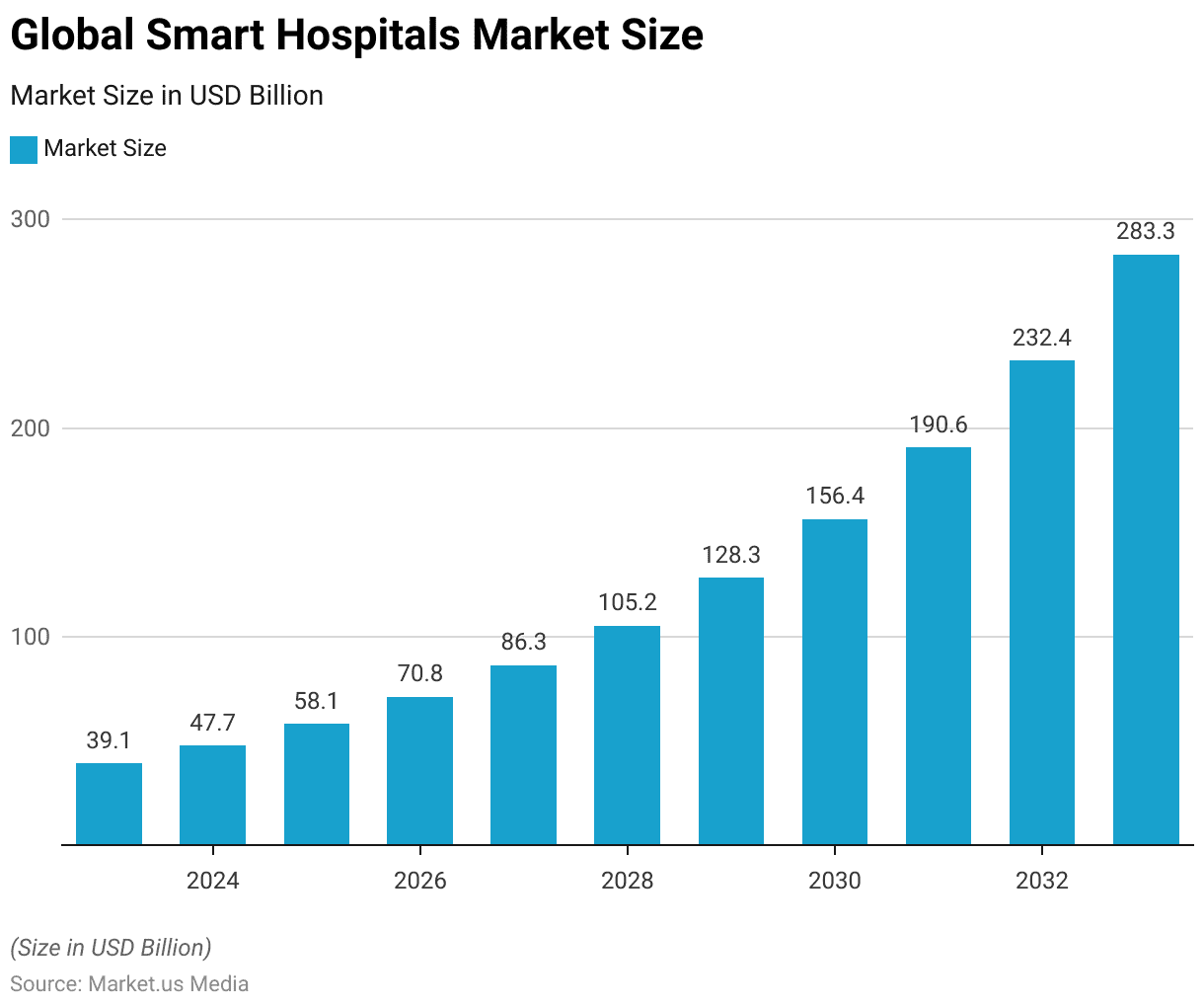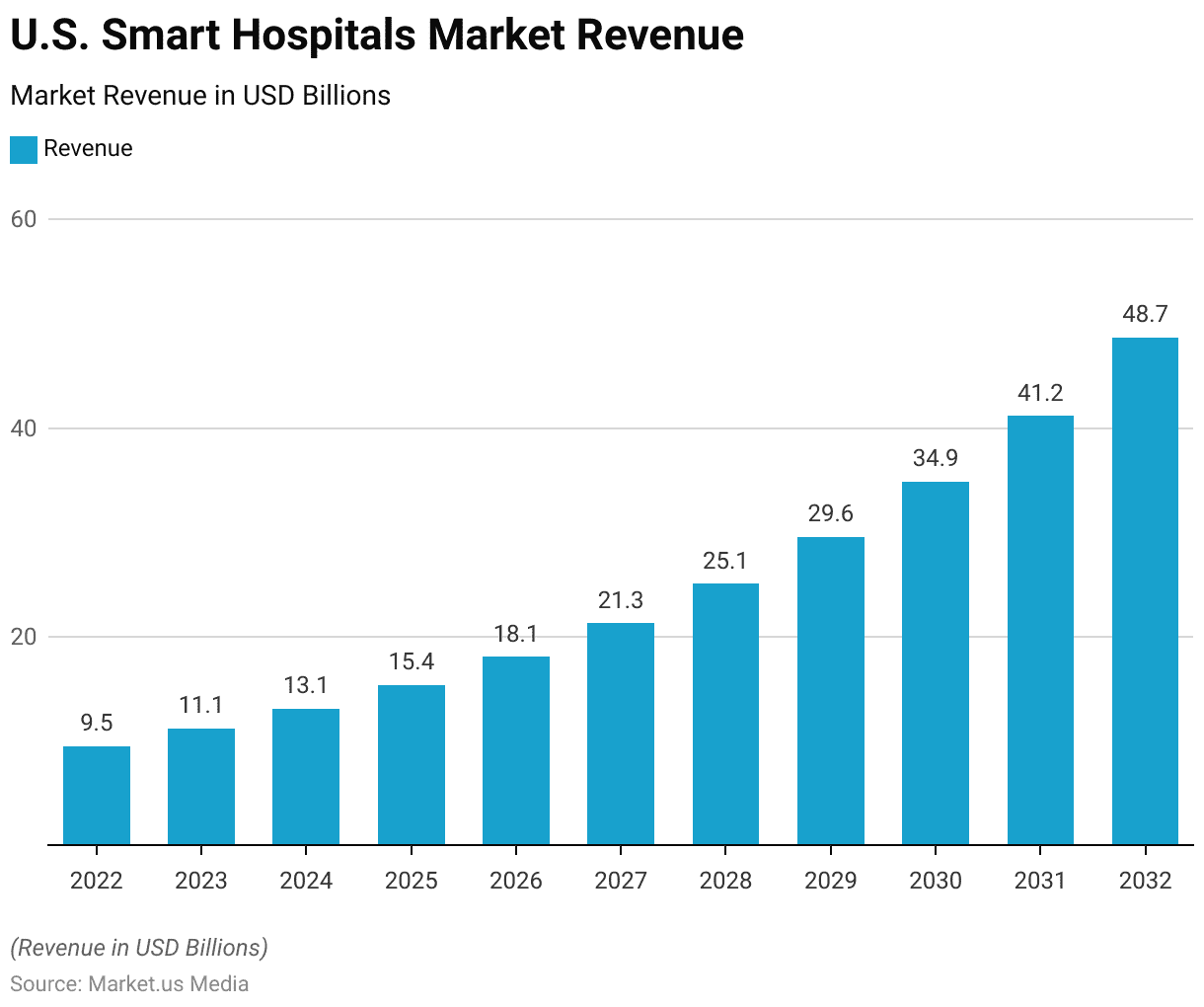According to Smart Hospital Statistics, Smart hospitals are modern healthcare facilities that harness advanced technologies and data-driven approaches to enhance patient care and operational efficiency.
They utilize digital health records, connected medical devices, remote patient monitoring, and automation to streamline processes and improve healthcare delivery.
These hospitals also prioritize patient engagement through mobile apps and portals, while predictive analytics aids in resource allocation and disease outbreak predictions.
Security and privacy are crucial considerations, in ensuring the confidentiality of medical records. Ultimately, smart hospitals aim to optimize workflows, reduce wait times, and provide an improved healthcare experience by integrating various innovative technologies.
Table of Contents
- Editor’s Choice
- Global Smart Hospital Market Overview
- Market Overview- By Components
- Global Market Overview- By Technology
- Global Smart Hospitals Market Overview- By Connectivity
- Global Smart Hospitals Market Overview- By Applications
- Regional Analysis of Smart Hospitals
- Emerging Technologies Used in Smart Hospitals
Editor’s Choice
- At a CAGR of 21.9%, the global smart hospital market is expected to rise from USD 39.1 billion to USD 283.3 billion in 2033.
- Hardware components like IoT and medical devices lead the market with over 40% market share.
- The technology of IoT dominates the market with a 35% market share.
- Wireless connectivity is majorly used taking up 60% of the market.
- North America is the leader in the smart hospital market with about 46% share.
- The Medical Connected Imaging Segment used in smart hospitals is the widely used tool with about 25% of the market share.
Global Smart Hospital Market Overview
- The Smart Hospital Market will reach USD 283.3 billion by 2033, at a CAGR of 21.9%. In 2023, the total was USD 39.1 billion.
- In 2023, the global smart hospital market is valued at $39.1 billion. This value is set to rise notably in 2024, reaching $47.7 billion. By 2025, the market is forecasted to expand further, reaching $58.1 billion.
- The growth momentum continues in 2026, with the market size increasing to $70.8 billion. In 2027, it is expected to climb to $86.3 billion, indicating a strong growth trend.
- The subsequent year, 2028, is projected to witness a substantial market size of $105.2 billion. Moving forward to 2029, the smart hospital market is estimated to be valued at $128.3 billion, and by 2030, it is anticipated to reach $156.4 billion.
- The upward trajectory persists in 2031, with the market expected to reach $190.6 billion. In 2032, the market size is forecasted to reach $232.4 billion, and finally, in 2033, it is estimated to stand at $283.3 billion.

Market Overview- By Components
- The Smart Hospital market is divided into hardware components, software components, and Services.
- The portable devices had a market value worth USD 60.44 billion in 2022 and are expected to reach USD 120.8 billion by 2030 at a CAGR of 9.04%.
- IoT sensors saw a market value of USD 11.1 billion in 2022. It will reach USD 29.6 billion by 2026 with a CAGR of 33.78%.
- Services, a segment of components used in smart hospitals, is projected to record a 22.5% CAGR and reach USD 137.6 Billion by 2030.
Global Market Overview- By Technology
IoT Technology
- The global market for healthcare Internet of Things (IoT) security is expected to reach USD 36.269 billion by 2032. This growth reflects a significant annual growth rate (CAGR) of 36%, starting from its 2022 valuation of USD 1.675 billion.
- IoT technology can be utilized for the care of both pediatric and elderly patients, as well as the continuous monitoring of chronic diseases.
- IoT-based medical devices, when worn or attached to a patient’s body, capture detailed health information.
Cloud computing
- The worldwide Healthcare Cloud Computing Market will substantially expand. It is expected to reach USD 201.1 billion by 2032, marking an increase from its 2022 valuation of USD 41.4 billion. This growth is attributed to a robust annual growth rate (CAGR) of 17.6% during the forecast period from 2023 to 2032.
Wearable Technology and Non-Wearable Technology
- The worldwide market for Smart Wearable and Non-Wearable Devices is poised for significant expansion, projected to reach an estimated worth of approximately USD 105.8 Billion by the year 2032.
- This marks a considerable upswing from its 2022 valuation of USD 29.0 Billion, underscoring a robust yearly growth rate (CAGR) of 14.2% throughout the forecast period that extends from 2023 to 2032.
Radio Frequency Technology
- This technology had a market value of USD 15.8 billion in 2023 and is growing at a CAGR of 11.1%. It is forecasted to reach USD 40.9 billion by 2032.

Global Smart Hospitals Market Overview- By Connectivity
- In 2023, the Smart Hospital market witnessed a significant shift in market share among its different connectivity segments. The Wireless Segment emerged as the dominant player, securing an impressive market share of over 60%.
- The global Wireless Health Market reached a valuation of USD 160.33 billion. It is now on a robust growth trajectory, with an annual growth rate of 23% anticipated throughout the forecast period spanning from 2023 to 2031.

Global Smart Hospitals Market Overview- By Applications
The Medical Connected Imaging Segment
- This segment took the lead by securing a substantial market share of over 25%, signifying the increasing significance of connected imaging solutions within the smart hospital sector.
- The worldwide market for medical imaging is set to expand, rising from USD 40.33 billion in 2023 to USD 61.51 billion by 2030. occurring at an annual rate of 6.2% during the forecast period.
Telemedicine
- The global telemedicine market is set for substantial expansion, with estimations suggesting it will reach a value of approximately USD 590.9 billion by 2032. This marks a significant increase from its 2022 valuation of USD 63.5 billion.
- Throughout the forecast period spanning from 2022 to 2032, the telemedicine sector is expected to maintain a robust Compound Annual Growth Rate (CAGR) of 25.7%.
Medical Assistance Application or Patient Engagement Solution
- The worldwide market for patient engagement solutions had an estimated worth of USD 17.2 billion in 2022. It will show significant growth, with a projected value of USD 68.17 billion by 2032. This growth is expected to occur steadily, with a Compound Annual Growth Rate (CAGR) of 15.3% during the forecast period from 2023 to 2032.
Electronic Health Records
- Electronic Health Records streamline administrative and clinical processes The Healthcare Information Systems Market Size is set for substantial growth, with an expected value of approximately USD 1,658.1 billion by 2033.
- This marks a significant increase from its 2023 value of USD 463.3 billion. This growth is anticipated to occur at an average annual rate of 13.6% during the forecast period spanning from 2024 to 2033.
Regional Analysis of Smart Hospitals
- North America occupied 46% of the market share in 2023. The U.S. market was at USD 11.14 billion in 2023 and is expected to surpass USD 48.68 billion by 2032, at a CAGR of 17.80%.
- In 2022, the U.S. Smart Hospitals market size was USD 9.5 billion which increased to USD 11.14 billion, indicating the start in the growth within the industry.
- The European Market will reach USD 24.08 billion by 2028 growing at a CAGR of 25.68%. The major regions include the UK and Germany.
- The APAC market will reach USD 49.82 billion by 2028 as compared to USD 15.5 billion in 2023, forecasted to grow at a CAGR of 25.26%.
- The APAC is the fastest-growing market after North America.

Emerging Technologies Used in Smart Hospitals
Communications
- IoT communication relies on various protocols, including NFC, Wi-Fi, RFID, UWB, Bluetooth, LTE, and more.
- NFC operates at 13.56 MHz with a 424 kbps data rate and a range of up to 10 cm.
- Wi-Fi allows data communication within a 100 m range, suitable for ad-hoc environments.
- RFID comprises readers and tags, with a communication range from 10 cm to 100 m.
- UWB technology, known for low energy and high bandwidth, is favored for low-coverage situations.
- Bluetooth facilitates short-distance data exchange with low energy consumption.
- LTE is a high-speed wireless communication standard for mobile phones, supporting up to 100 MHz bandwidth and spatial multiplexing.
IoT based Ambulance
- This initiative involves outfitting each ambulance with crucial equipment, including GPS and a GSM modem. In emergencies, these devices collaborate to send the ambulance’s GPS coordinates to a cloud server.
- Subsequently, the cloud server calculates the shortest route from the ambulance’s current location to the hospital, passing through the place where the emergency call originated. To implement this project, essential hardware components such as the GSM Module SIM900A, Arduino UNO, and cloud computing infrastructure are employed. These components work together to enable data transmission and processing.
Telemart
- Telemart technology has proven to be particularly useful in the realm of the Internet of Things (IoT), especially during challenging times like the COVID-19 pandemic.
- For example, maintaining a 6-foot distance in crowded places such as supermarkets has become a significant concern.
- Recently, Amazon adopted Telemart solutions by offering customers a QR code at the store entrance.
- This QR code allows them to enter the store and shop. Following their shopping, the cost of their purchases is automatically deducted from their Amazon accounts.
Mobile IoT
- One study introduced a system based on m-IoT, aiming to monitor the glucose levels of diabetic patients, which proved to be beneficial for managing hypoglycemia.
- In a separate research effort, a mobile gateway-driven HIoT system known as “AMBRO” was created.
- This system made use of various sensors to detect falls and monitor heart rates.
- Additionally, it possessed the capability to determine the precise location of patients through an integrated GPS module.
- Furthermore, in another study, it was discussed that this system effectively identifies irregular heart activity and promptly notifies patients when their heart rate exceeds the range of 60 to 100 beats per minute.
Discuss your needs with our analyst
Please share your requirements with more details so our analyst can check if they can solve your problem(s)



